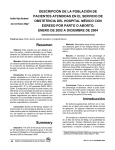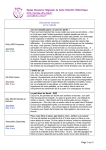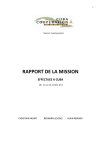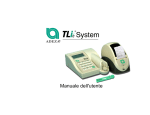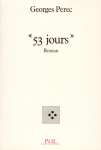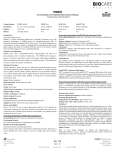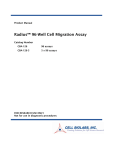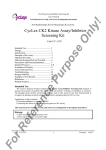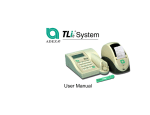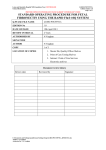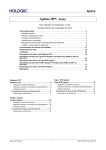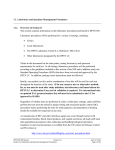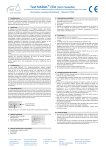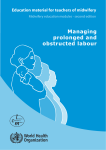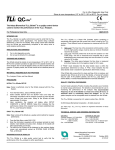Download RAPiD fFN Cassette Kit - fFN (Fetal Fibronectin) Test
Transcript
For In Vitro Diagnostic Use Only Store at room temperature (15° to 30°C / 59° to 86°F). RAPiD fFN Cassette Kit For Professional Use Only 01200 INTENDED USE The Rapid fFN Cassette for use in the TLiIQ® System is an in vitro diagnostic device for the detection of fetal fibronectin in cervicovaginal secretions to be used as an aid to rapidly assess the risk of preterm delivery in ≤ 7 or ≤ 14 days from the time of cervicovaginal sample collection in pregnant women with signs and symptoms of early preterm labor, intact amniotic membranes and minimal cervical dilatation (< 3 cm), sampled between 24 weeks, 0 days and 34 weeks, 6 days of gestation. The Rapid fFN test is further indicated for use in conjunction with other clinical information as an aid to rapidly assess the risk of preterm delivery in ≤ 34 weeks, 6 days when a cervicovaginal sample is obtained during a routine prenatal visit between 22 weeks, 0 days and 30 weeks, 6 days of gestation in women with a singleton pregnancy. The Rapid fFN test represents a significant and critically needed improvement in the ability to manage preterm labor that may result in preterm delivery. CONTRAINDICATIONS The Rapid fFN test should not be used for symptomatic women with one or more of the following conditions: • advanced cervical dilatation (≥ 3 centimeters) • rupture of amniotic membranes • cervical cerclage Caution, consult accompanying documents In Vitro Diagnostic Medical Device Use by Batch code Authorized Representative in the European Community 30˚C 15˚C Temperature limitation: 15°–30°C Catalogue Number Do not reuse Manufacturer English – 1 • moderate or gross vaginal bleeding Delivery typically occurs imminently when the cervix is dilated more than 3 centimeters or if the amniotic membranes are ruptured. Additional diagnostic testing is usually not necessary to confirm risk for women with advanced cervical dilatation or rupture of amniotic membranes. Moderate or gross vaginal bleeding is an independent risk factor for preterm delivery and may be associated with other severe obstetrical or medical problems. Clinical attention should be focused on identification of the origin of bleeding rather than immediate assessment of delivery risk. At this time, information is insufficient regarding the association of vaginal fetal fibronectin expression to delivery for women with cervical cerclage. The Rapid fFN test should not be used for asymptomatic women with one or more of the following conditions: • multiple gestations, e.g., twins • cervical cerclage • placenta previa (partial or complete) • sexual intercourse in the preceding 24 hours At this time, information is insufficient regarding the association of cervicovaginal fetal fibronectin expression to delivery for asymptomatic women with HIV/AIDS, multiple gestations or cervical cerclage. SUMMARY AND EXPLANATION OF THE TEST Of the approximately 4,000,000 deliveries that occur annually in the United States, about 400,000 are premature. Preterm delivery, defined by the American College of Obstetricians and Gynecologists as delivery prior to the 37th week of gestation, is responsible for the majority of non-chromosomal perinatal morbidity and mortality (1–4). Symptoms of threatened preterm delivery include uterine contractions, change of vaginal discharge, vaginal bleeding, backache, abdominal discomfort, pelvic pressure, and cramping. Diagnostic modalities for identification of threatened preterm delivery include uterine activity monitoring and performance of a digital cervical examination, which allows estimation of cervical dimensions. These methods have been shown to be limited, as minimal cervical dilatation (< 3 centimeters) and uterine activity occur normally and are not necessarily diagnostic of imminent preterm delivery (5,11,13). While several serum biochemical markers have been evaluated, none have been widely accepted for practical clinical use (6,7,20). Fetal fibronectin (fFN), an isoform of fibronectin, is a complex adhesive glycoprotein with a molecular weight of approximately 500,000 daltons (8,9). Matsuura and co-workers have described a monoclonal antibody called FDC-6, which specifically recognizes III-CS, the region defining the fetal isoform of fibronectin (8,9). Immunohistochemical studies of placentae have shown that fFN is confined to the extracellular matrix of the region defining the junction of the maternal and fetal units within the uterus (5,10). Fetal fibronectin can be detected in cervicovaginal secretions of women throughout pregnancy by use of a monoclonal antibodybased immunoassay. Fetal fibronectin is elevated in cervicovaginal secretions during the first 24 weeks of pregnancy but is diminished between 24 and 34 weeks in normal pregnancies. The significance of its presence in the vagina during the first 24 weeks of pregnancy is not understood. However, it may simply reflect the normal growth 2 – English of the extravillous trophoblast population and the placenta. Detection of fFN in cervicovaginal secretions between 24 and 34 completed weeks gestation is reported to be associated with preterm delivery in symptomatic (5,11-15) and asymptomatic pregnant women (16–19). PRINCIPLE OF THE TEST The Rapid fFN Cassette is a lateral flow, solid-phase immunochromatographic assay. The cervicovaginal specimen is extracted into a buffer and a 200 µL sample is dispensed into the sample application well of the Rapid fFN Cassette. The sample flows from an absorbent pad across a nitrocellulose membrane via capillary action through a reaction zone containing murine monoclonal anti-fetal fibronectin antibody conjugated to blue microspheres (conjugate). The conjugate, embedded in the membrane, is mobilized by the flow of the sample. The sample then flows through a zone containing goat polyclonal antihuman fibronectin antibody which captures the fibronectin-conjugate complexes. The remaining sample flows through a zone containing goat polyclonal anti-mouse IgG antibody which captures unbound conjugate, resulting in a control line. After 20 minutes of reaction time, the intensities of the test line and control line are interpreted with the TLiIQ® Analyzer. PRECAUTIONS AND WARNINGS Note: Transport specimens at 2° to 25°C, or frozen. Specimens are stable for up to eight (8) hours at room temperature. Specimens not tested within eight hours of collection must be stored refrigerated at 2° to 8ºC and assayed within three (3) days of collection, or frozen and assayed within three (3) months to avoid degradation of the analyte. Specimens arriving frozen may be tested as described below (subject to a single freeze-thaw cycle only). 1. For in vitro diagnostic use only. 2. Carefully follow the instructions and procedures described in this insert. 3. Test results may not be interpreted visually and must be based on the use of the TLiIQ System. 4. Do not use glass tubes or glass pipettes, as fetal fibronectin binds to glass. Tubes and pipettes of polypropylene or polyethylene are acceptable. 5. Do not mix materials from different kit lots. 6. Do not use cassettes or controls past their expiration dates. 7. Do not use controls if they are cloudy or discolored. Avoid crosscontamination of reagents. Use a new pipette tip for each control or patient sample. Recap controls tightly with the correct color-coded caps. 8. Handle cassettes with care; do not touch, scratch, or compress membrane materials in the Rapid fFN Cassette. 9. Source material used to prepare the controls is of human origin. The donors were tested and found to be negative for HIV 1, HIV 2, and HCV English – 3 antibody and hepatitis B surface antigen (HBsAg) using established methods. No known test method can offer total assurance that HIV, hepatitis C virus, hepatitis B virus, or other infectious agents are absent. Handle the controls and all patient specimens as if potentially infectious. 10. Labels (e.g., bar code labels) can be placed on the thumb grip area of the cassette. Do not place labels on an area of the cassette that will be inserted into the TLiIQ® Analyzer. STORAGE The Rapid fFN Cassettes should be stored at room temperature (15° to 30°C / 59° to 86°F). STABILITY The shelf life of the Rapid fFN Cassette is 18 months from the date of manufacture. Unopened cassettes may be used until the expiration date printed on the foil pouch and the box containing the pouched cassettes. Once the foil pouch is opened, the Rapid fFN Cassette should be used immediately. MATERIALS PROVIDED Rapid fFN for the TLiIQ® System, REF 01200 (includes Cassettes and Directional Insert). MATERIALS REQUIRED BUT NOT PROVIDED 1. TLiIQ System, REF 01202 (includes Analyzer, Printer, User Manual, and TLiIQ QCette® ) 2. Rapid fFN Control Kit, REF 01166 (includes Positive Control, Negative Control, and Directional Insert) 3. 200 µL pipette SPECIMEN COLLECTION The Cytyc Specimen Collection Kit for FullTerm™, The Fetal Fibronectin Test, is the only acceptable specimen collection system that can be used to collect specimens for this assay. See the Specimen Collection Kit directional insert for complete instructions. PROCEDURE PERFORMING ANALYZER QUALITY CONTROL Use the TLiIQ QCette to ensure proper function of the TLiIQ Analyzer. See the TLiIQ QCette directional insert for complete instructions. SETTING CALIBRATION FOR A RAPID fFN CASSETTE LOT Select SET CALIBRATION from the TLiIQ Analyzer Main Menu and enter the information requested (Cassette Lot # and Calibration Code #). The Cassette Lot # is located on the cassette pouch. The Calibration Code # is located on the cassette box. See the TLiIQ System User Manual for details. 4 – English RUNNING RAPID fFN CONTROL KIT The Rapid fFN Control Kit must be run each time a new lot or a new shipment of Rapid fFN Cassettes is received. Run the liquid controls as if testing patient samples. See the Rapid fFN Control Kit directional insert for complete instructions. Note: For your convenience, space is provided on the Rapid fFN Cassette Kit box for control testing documentation. SPECIMEN PREPARATION Note: Handle the Specimen Transport Tube and all Patient Specimens as if potentially infectious. 1. Allow all Specimen Transport Tubes to come to room temperature before testing. 2. Gently mix the Specimen Transport Tube prior to removing the swab. 3. Open the Specimen Transport Tube cap and swab assembly. The swab shaft should be seated in the cap. Express as much liquid as possible from the swab by rolling the tip against the inside of the tube. Dispose of the used swab in a manner consistent with handling biohazardous materials. TESTING PATIENT SAMPLES Incubation Mode – Internal Note: The default setting for the TLiIQ Analyzer is Internal Incubation Mode. In this mode, the analyzer will time the incubation and automatically initiate reading of the cassette when incubation is complete. 1. Prepare Patient Samples according to the Specimen Preparation section. Mix patient samples before testing. 2. Remove one Rapid fFN Cassette from the foil pouch. 3. Select VIEW SETUP from the TLiIQ Analyzer Main Menu to determine if the analyzer is set to Internal Incubation Mode. If Internal Mode is indicated, proceed to step 4. If the analyzer is not set to Internal Mode, select CHANGE SETUP from the Main Menu and change to Internal Incubation Mode. See the TLiIQ System User Manual for details. 4. Select TEST PATIENT from the TLiIQ Analyzer Main Menu and enter the necessary information until the analyzer prompts for cassette insertion. 5. Insert the cassette into the analyzer and press ENTER. 6. When prompted by the analyzer, pipette 200 µL of patient sample into the sample application well of the Rapid fFN Cassette. Immediately press ENTER to activate the analyzer. 7. The analyzer will count down for 20 minutes and analyze the Rapid fFN Cassette. 8. The fFN result for the patient sample will be displayed on the TLiIQ Analyzer display screen as POSITIVE, NEGATIVE, or INVALID. English – 5 9. If an INVALID result is obtained, retest with 200 µL of additional sample, if available, on a new cassette. If the problem is not corrected, see the TLiIQ System User Manual for details, or contact Cytyc for technical assistance. Incubation Mode – External Note: In External Incubation Mode, the user is responsible for timing the incubation and starting the analysis. If additional cassettes are run, wait 5 minutes before adding sample to the next cassette to allow for the analysis of the previous cassette (approximately 3 minutes) and for entering menu information required by the analyzer for the next cassette. 1. Prepare Patient Samples according to the Specimen Preparation section. Mix patient samples before testing. 2. Remove one Rapid fFN Cassette from the foil pouch. 3. Select VIEW SETUP from the TLiIQ Analyzer Main Menu to determine if the analyzer is set to External Incubation Mode. If External Mode is indicated, proceed to step 4. If the analyzer is not set to External Mode, select CHANGE SETUP from the Main Menu and change to External Incubation Mode. See the TLiIQ System User Manual for details. 4. Select TEST PATIENT from the TLiIQ Analyzer Main Menu and enter the necessary information until the analyzer prompts for cassette insertion. 5. Pipette 200 µL of patient sample into the sample application well of the Rapid fFN Cassette and allow to incubate at room temperature for 20 minutes. 6. When the incubation time is complete, insert the cassette into the analyzer and press ENTER. The analyzer will complete the analysis of the Rapid fFN Cassette. 7. The fFN result for the patient sample will be displayed on the TLiIQ Analyzer display screen as POSITIVE, NEGATIVE, or INVALID. 8. If an INVALID result is obtained, retest with 200 µL of additional sample, if available, on a new cassette. If the problem is not corrected, see the TLiIQ System User Manual for details, or contact Cytyc for technical assistance. INTERPRETATION OF RESULTS The fFN result for the patient sample will be displayed on the TLiIQ Analyzer display screen as POSITIVE, NEGATIVE, or INVALID. The result is positive if the value derived from the patient sample is greater than or equal to the reference calibration value specified by the calibration code. The result is negative if the value derived from the patient sample is less than the reference calibration value specified by the calibration code. The result is invalid if the test does not meet internal quality controls. QUALITY CONTROL PROCEDURES Current Good Laboratory Practice includes the daily use and documentation of either liquid controls or electronic (internal) controls to assure that the calibration of the diagnostic device is maintained within acceptable limits. 6 – English The Rapid fFN Control Kit (REF 01166) contains two liquid controls: one Rapid fFN Positive Control and one Rapid fFN Negative Control. The controls are recommended for use in monitoring the performance of the Rapid fFN Cassette. The recommended frequency of use of the controls is once each time a new lot or a new shipment of cassettes is received, or whenever there is uncertainty about Rapid fFN Cassettes. Deviation from the recommended frequency of quality control testing must be validated by the laboratory. If the criteria for controls are not met, do not test patient samples until acceptable results are obtained. The TLiIQ QCette is a quality control device used to verify that the TLiIQ Analyzer performs within specification. The TLiIQ QCette is a Rapid fFN Cassette replica, containing a membrane with printed test and control lines, which is read by the TLiIQ Analyzer. Three different levels of response are measured with this QC device: 1. High Level: The blue line at the procedural control position, which is in the high positive range, must be above a minimum threshold value for QC to pass. 2. Low Level: The blue printed line at the test line position is in the cutoff range. This line is measured and compared with a value established during instrument setup and must be within 5% of that value for QC to pass. 3. Negative: The white space between the blue lines is measured and should always be in the negative range for QC to pass. Internal controls monitor all components of the TLiIQ System and are performed automatically with every test. These internal controls check for: (1) a threshold level of signal at the procedural control position, (2) proper sample flow across the Rapid fFN Cassette, (3) absence of conjugate aggregation (Cassette: Pass/Fail), and (4) proper function of analyzer hardware (Analyzer: Pass/Fail). LIMITATIONS The Rapid fFN result should not be interpreted as absolute evidence for the presence or absence of a process that will result in delivery in ≤ 7 days or ≤ 14 days from specimen collection in symptomatic women or delivery in ≤ 34 weeks, 6 days in asymptomatic women evaluated between 22 weeks, 0 days and 30 weeks, 6 days of gestation. A positive fFN result may be observed for patients who have experienced cervical disruption caused by, but not limited to, events such as sexual intercourse, digital cervical examination, or vaginal probe ultrasound. The Rapid fFN result should always be used in conjunction with information available from the clinical evaluation of the patient and other diagnostic procedures such as cervical examination, cervical microbiological culture, assessment of uterine activity, and evaluation of other risk factors. • Test results may not be interpreted visually and must be based on the use of the TLiIQ System. • Modification of the assay protocol described herein may yield erroneous results. • The assay has been optimized with specimens taken from the posterior fornix of the vagina or the ectocervical region of the external cervical os. Samples obtained from other locations should not be used. English – 7 • The safety and effectiveness of using a cutoff other than that provided by the Rapid fFN Cassette Calibration Code has not been established. • Assay interference from the following components has not been ruled out: douches, white blood cells, red blood cells, bacteria, and bilirubin. • The presence of infections has not been ruled out as a confounding factor to risk of preterm delivery. • Assay interference from semen has not been ruled out. Specimens should not be collected less than 24 hours after intercourse. However, even when a patient reports having had intercourse in the previous 24 hours, a negative fetal fibronectin test result is valid. • Specimens should be obtained prior to digital examination or manipulation of the cervix. Manipulations of the cervix may lead to false positive results. • Patients with suspected or known placental abruption, placenta previa, or moderate or gross vaginal bleeding should not be tested. EXPECTED VALUES Among symptomatic women, elevated levels (≥ 0.050 µg/mL) of fFN between 24 weeks, 0 days and 34 weeks, 6 days indicate increased risk of delivery in ≤ 7 or ≤ 14 days from sample collection. Similarly, among asymptomatic women, elevated levels of fFN between 22 weeks, 0 days and 30 weeks, 6 days indicate increased risk of delivery in ≤ 34 weeks, 6 days of gestation. The cutoff of 0.050 µg/mL fFN was established in a multicenter study conducted to evaluate the association between fetal fibronectin expression during pregnancy and preterm delivery (5). Only subjects with symptoms of preterm labor or preterm rupture of membranes were eligible for this study. Of the total study population, the association of vaginal fetal fibronectin expression to preterm delivery was evaluated for 117 symptomatic women with intact amniotic membranes. The strength of this association was determined at a variety of cutoffs using receiver operator characteristic (ROC) curves. These results show that the optimal sensitivity and specificity is provided at a cutoff of 0.050 µg/mL fFN. Subsequent studies evaluating the fFN Enzyme Immunoassay test as a predictor of preterm delivery among symptomatic women and asymptomatic women with singleton pregnancies have confirmed that the optimal cutoff is 0.050 µg/mL fFN (5,13,15,18). Laboratory studies have confirmed the optimal cutoff of 0.050 µg/mL fFN in the Rapid fFN. This analytical cutoff was used to show equivalency between the fFN Enzyme Immunoassay and the Rapid fFN. PERFORMANCE CHARACTERISTICS Accuracy A comparison of the Fetal Fibronectin Enzyme Immunoassay to the Rapid fFN was assessed in 587 cervicovaginal samples. The two test formats were equivalent 94.9% of the time. The Kappa coefficient for inter-test agreement was 0.81 with 95% confidence interval of [0.75, 0.88]. 8 – English Table Analytical Concordance Between fFN Enzyme Immunoassay and Rapid fFN (n=587) (Symptomatic and Asymptomatic Women) fFN Enzyme Immunoassay (+) fFN Enzyme Immunoassay (-) Rapid fFN (+) 77 17 94 Rapid fFN (-) 13 480 493 90 497 587 Within-Run Reproducibility Within-run reproducibility was determined using three lots of Rapid fFN Cassettes. Twenty replicates each of the Rapid fFN Negative Control (fFN concentration approximately 0.015 µg/mL) and of the Rapid fFN Positive Control (fFN concentration approximately 0.080 µg/ mL) were tested on three lots of Rapid fFN Cassettes using three different TLiIQ Analyzers. (One lot of cassettes was run on one analyzer on one day, on three different occasions.) The results from these studies show that the Rapid fFN correctly identified all specimens 100% of the time. Between-Run Reproducibility Between-run reproducibility was determined in 36 independent assays, using different lot combinations of Rapid fFN Cassettes (three lots) and TLiIQ Analyzers (six each). Each assay consisted of the Rapid fFN Negative Control and assay of the Rapid fFN Positive Control. The Rapid fFN correctly identified all samples 100% of the time. Interfering Substances Care must be taken not to contaminate the swab or cervicovaginal secretions with lubricants, soaps, disinfectants, or creams (e.g., K-Y® Jelly lubricant, Betadine® disinfectant, Monistat® cream). Lubricants or creams may physically interfere with absorption of the specimen onto the swab. Soaps or disinfectants may interfere with the antibodyantigen reaction. Various concentrations of pharmacologic agents were added to specimens containing approximately 0.015 µg/mL to 0.080 µg/mL fFN and assayed in triplicate. The drugs added were: prostaglandin E2 (up to 250 µg/mL), ampicillin (up to 100 µg/mL), cephalexin (up to 18 µg/ mL), erythromycin (up to 10 µg/mL), gentamycin (up to 4 µg/mL), dexamethasone (up to 200 µg/mL), magnesium sulfate (up to 50 µg/ mL), oxytocin (up to 100 µg/mL), terbutaline (up to 100 µg/mL), and ritodrine (up to 10 µg/mL). These drugs did not interfere with the assay at the concentration limits cited above. BIBLIOGRAPHY 1. American College of Obstetricians and Gynecologists. Preterm Labor. Technical Bulletin, Number 133, October, 1989. 2. Creasy RK, Resnick R. Maternal and Fetal Medicine: Principles and Practice. Philadelphia: W.B. Saunders; 1989. English – 9 3. Creasy RK, Merkatz IR. Prevention of preterm birth: clinical opinion. Obstet Gynecol 1990;76(Suppl 1):2S–4S. 4. Morrison JC. Preterm birth: a puzzle worth solving. Obstet Gynecol 1990;76(Suppl 1):5S–12S. 5. Lockwood CJ, Senyei AE, Dische MR, Casal DC, et al. Fetal fibronectin in cervical and vaginal secretions as a predictor of preterm delivery. New Engl J Med 1991;325:669–74. 6. Maymon R, Bahari C, Moroz C. Placental isoferritin measured by a specific monoclonal antibody as a predictive marker for preterm contraction outcome. Obstet Gynecol 1989;74:597–9. 7. Wasmoen TL, Coulam CB, Leiferman KM, Gleich GJ. Increases of plasma eosinophil major basic protein levels late in pregnancy predict onset of labor. Proc Natl Acad Sci USA 1987;84:3029–32. 8. Matsuura H, Hakomori SI. The oncofetal domain of fibronectin defined by the monoclonal antibody FDC-6: its presence in fibronectins from fetal and tumor tissues and its absence in those from normal adult tissues and plasma. Proc Natl Acad Sci USA 1985;82:6517–21. 9. Matsuura H, Takio K, Titani K, Greene T, et al. The oncofetal structure of human fibronectin defined by monoclonal antibody FDC-6. Unique structural requirement for the antigen specificity provided by a glycosylhexapeptide. J Biol Chem 1988;263:3314–22. 10. Feinberg RF, Kliman HJ, Lockwood CJ. Is oncofetal fibronectin a trophoblast glue for human implantation? Am J Pathol 1991;138:537–43. 11. Morrison JC, Allbert JR, McLaughlin BN, Whitworth NS, et al. Oncofetal fibronectin in patients with false labor as a predictor of preterm delivery. Am J Obstet Gynecol 1993;168:538–42. 12. Inglis SR, Jeremias J, Kuno K, Lescale K, et al. Detection of tumor necrosis factor-α, interleukin-6, and fetal fibronectin in the lower genital tract during pregnancy: relation to outcome. Am J Obstet Gynecol 1994;171:5–10. 13. Iams J, Casal DC, Goodwin TM, Kreaden US, et al. Fetal fibronectin improves the accuracy of diagnosis of preterm delivery. Am J Obstet Gynecol 1995;173:141–5. 14. Burrus DR, Ernest JM, Veille JC. Fetal fibronectin, interluekin-6, and C-reactive protein are useful in establishing prognostic subcategories of idiopathic preterm labor. Am J Obstet Gynecol 1995;173:1258–62. 15. Bartnicki J, Casal DC, Kreaden US, Saling E, Vetter K. Fetal fibronectin in vaginal specimens predicts preterm delivery and very low birth weight infants. Am J Obstet Gynecol 1996;174:971–4. 16. Lockwood CJ, Wein R, Lapinski R, Casal D, et al. The presence of cervical and vaginal fetal fibronectin predicts preterm delivery in an inner-city obstetric population. Am J Obstet Gynecol 1993;169:798–804. 10 – English 17. Leeson SC, Maresh MJA, Martindale EA, Mahmood T, et al. Detection of fetal fibronectin as a predictor of preterm delivery in high risk asymptomatic pregnancies. Br J Obstet Gynecol 1996;103:48–53. 18. Goldenberg RL, Mercer BM, Meis PJ, Copper RL, et al. The preterm prediction study: fetal fibronectin testing and spontaneous preterm birth. Obstet Gynecol 1996;87:643–8. 19. Morrison JC, Naef RW, Botti JJ, Katz M, et al. Prediction of spontaneous preterm birth by fetal fibronectin and uterine activity. Obstet Gynecol 1996;87:649–55. 20. McGregor JA. Salivary estriol as risk assessment for preterm labor: a prospective trial. Am J Obstet Gynecol 1995;173:1337–42. The Rapid fFN Cassette Kit, the TLiIQ System, the TLiIQ QCette, and the Specimen Collection Kit and their use are covered by one or more of the following patents granted or licensed to Cytyc Corporation: U.S. patent numbers 4,894,326; 4,919,889; 5,096,830; 5,243,029; 5,281,522; 6,267,722; 6,394,952; Des. 432,244; Des. 434,153; and one or more corresponding foreign patents. © 2008 Hologic, Inc. All rights reserved. K-Y is a registered trademark of Johnson & Johnson. Betadine is a registered trademark of Purdue Frederick. Monistat is a registered trademark of Ortho Pharmaceuticals. FullTerm, Cytyc, TLiIQ, and TLiIQ QCette and/or associated logos are trademarks and/or registered trademarks of Hologic, Inc. and/or its subsidiaries in the United States and/or other countries. TECHNICAL SERVICE AND ORDERING INFORMATION USA/CANADA ONLY Tel: Fax: 1-888-PRETERM (1-888-773-8376) 1-508-263-2956 ALL OTHER COUNTRIES Tel: +1-508-263-2900 For additional contact information, go to www.fullterm.net Cytyc Corporation • 1240 Elko Drive • Sunnyvale, CA • 94089-2212 • USA • www.cytyc.com Cytyc UK Ltd • Link 10 Napier Way • Crawley, West Sussex • RH10 9RA • UK • +44 (0) 1293 522 080 05811-001 Rev M English – 11











